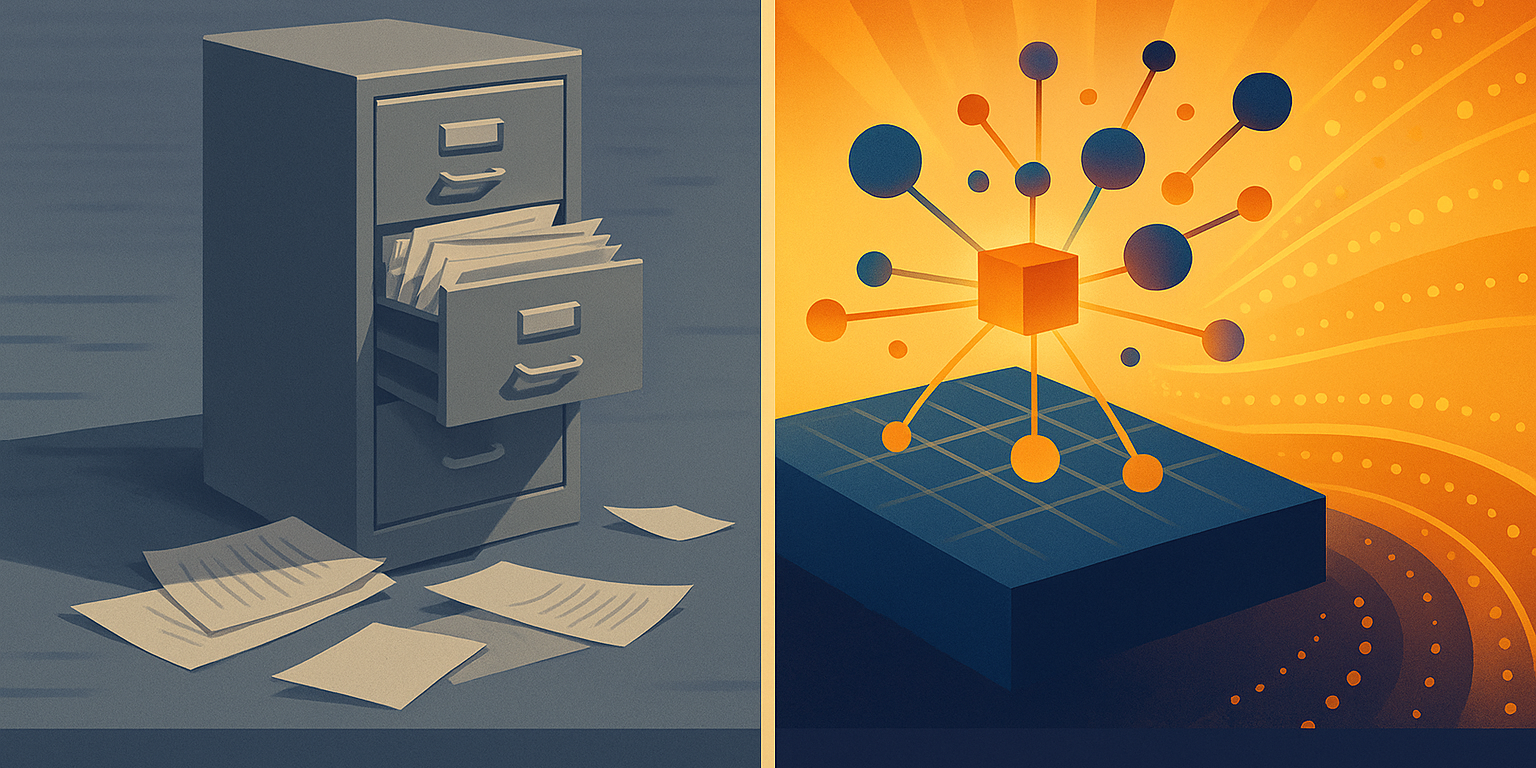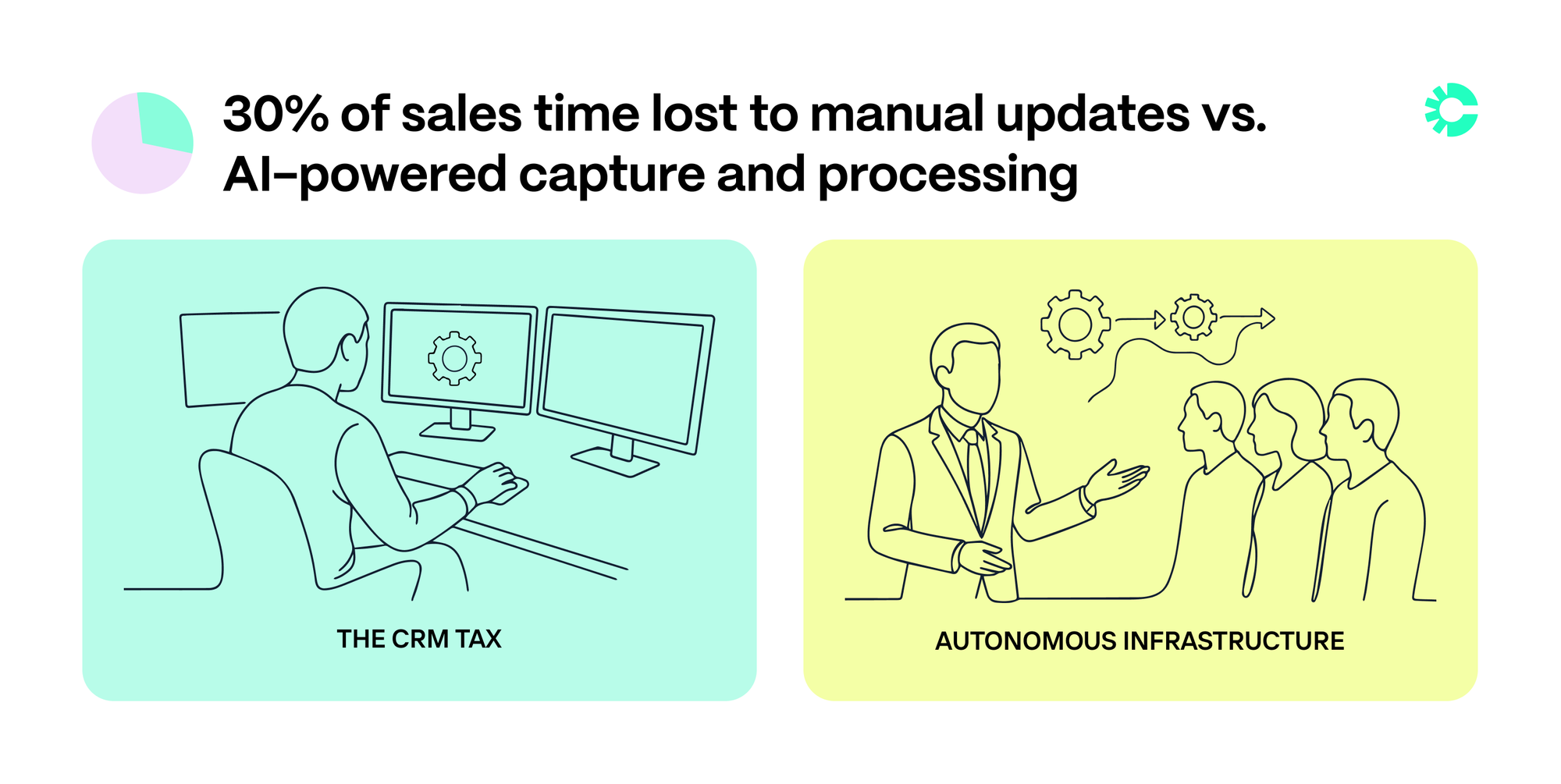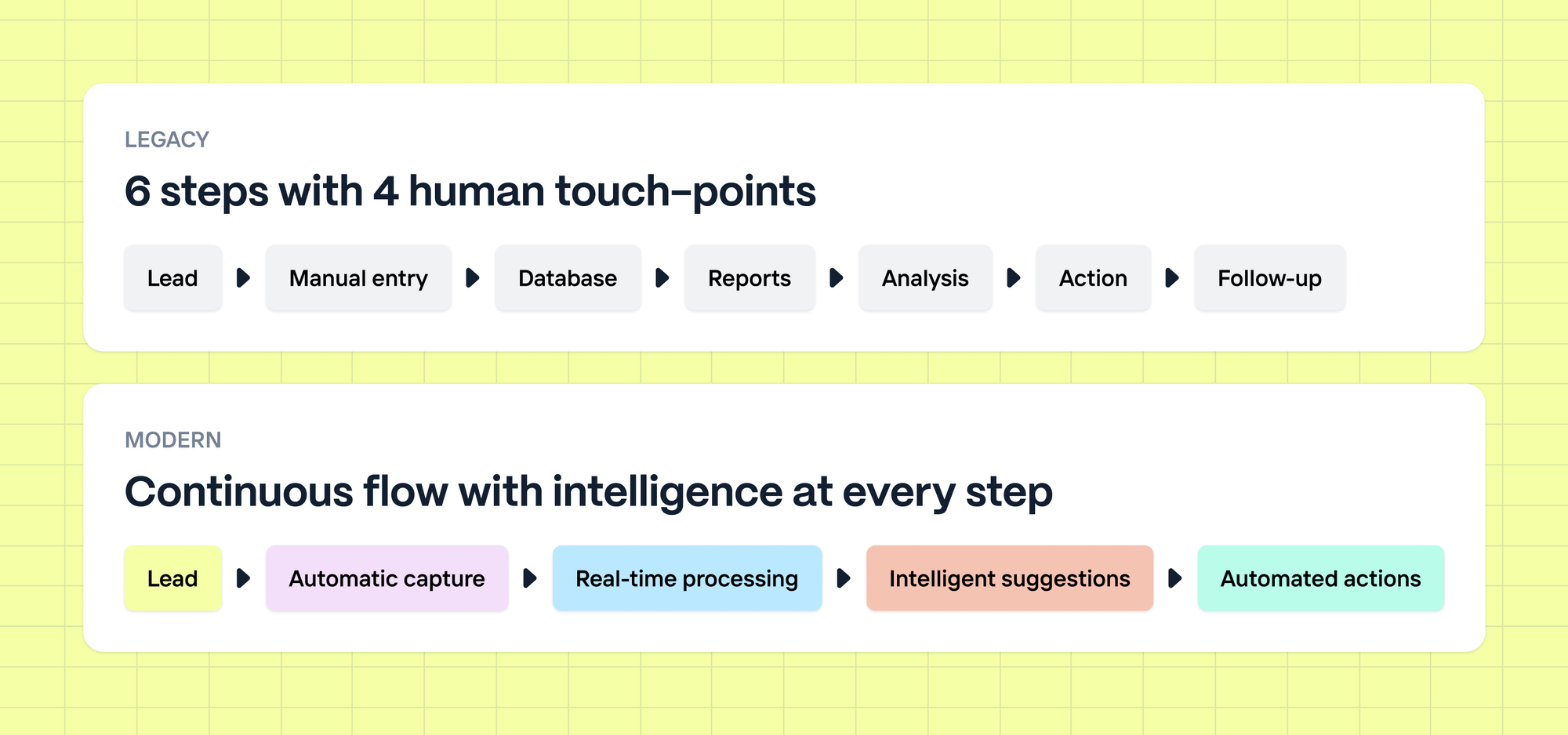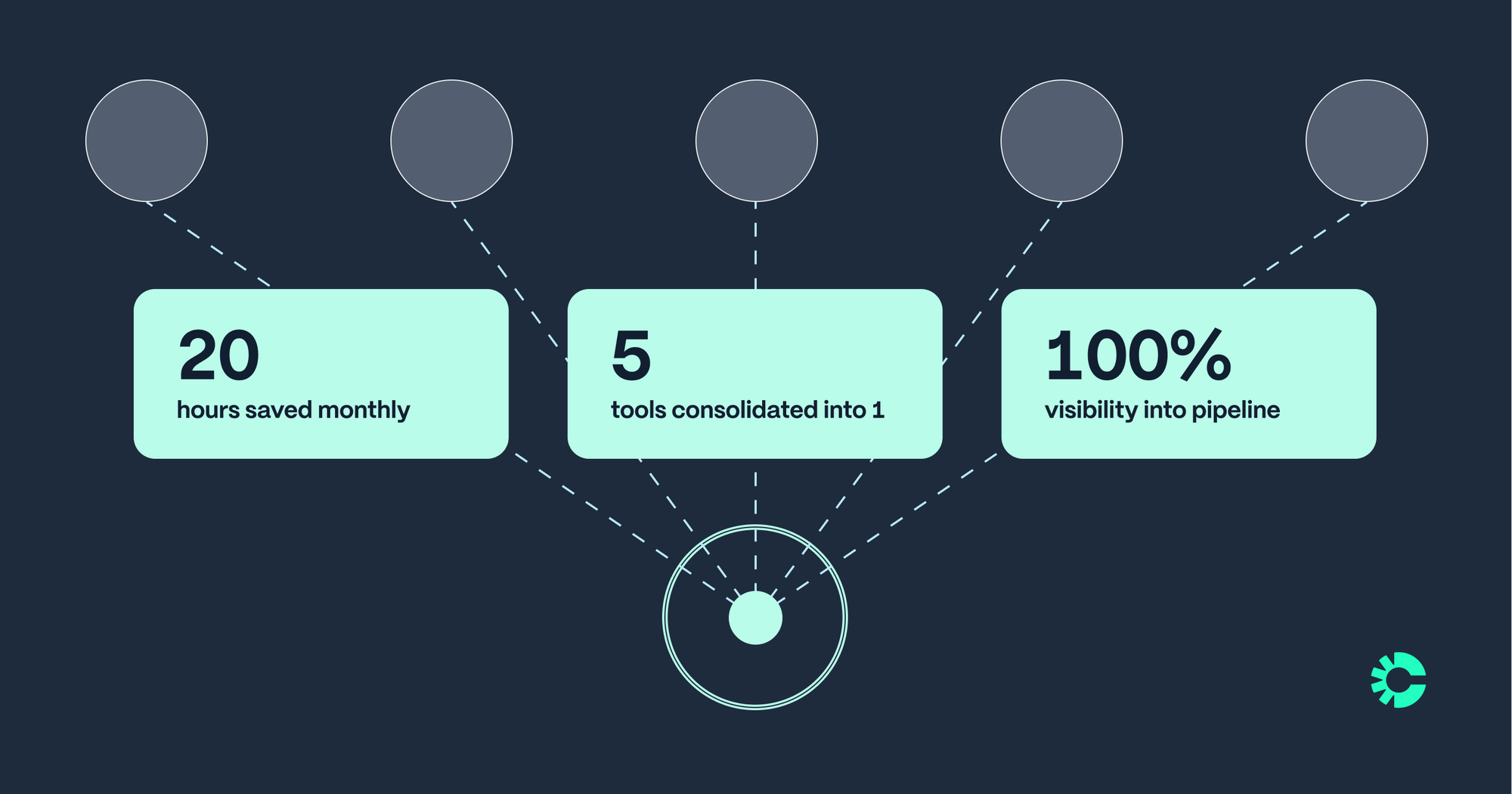Why modern CRMs will be the core of your GTM engine

Most teams still treat their customer relationship management (CRM) system like a digital filing cabinet — a static place where data goes to sit, not a system that moves work forward. It’s no wonder pipeline reviews feel disconnected, go-to-market (GTM) execution feels brittle, and nobody trusts the numbers.
But what if your CRM wasn’t a chore to update — or a system to report to? What if it actually ran your GTM motion?
The most forward-thinking teams are already operating this way. And the longer everyone else waits, the harder it’ll be to catch up.
Infrastructure over interfaces
The legacy CRM mindset is rooted in manual reporting. A seller updates a field, a manager runs a report, and RevOps tries to patch the gaps in between.
Meanwhile, product teams don’t operate like this. They build on top of systems that observe, learn, and trigger action. Their infrastructure creates leverage.
Your GTM team deserves the same foundation.
At Austin’s last company, they had a 10-person RevOps team managing their Salesforce instance. Ten people whose job was essentially fighting with a system that should have been working for them. The best salespeople we know are ruthless operators, but they shouldn't have to be database administrators.
Modern operators are already multiplying their output. Designers are shipping code, and engineers are making design decisions with the help of AI. This same evolution is coming for GTM — but only for teams with systems designed to support it.
At Clarify, we have a designer who is writing a ton of code right now because he has Cursor. We have engineers who are doing design because they have Copilot."
It’s not about job titles — it’s about capability. And this capability compounds when the systems beneath you are built for speed, not for supervision.
From database to GTM engine
Here’s what it looks like when your CRM stops acting like a database and starts behaving like infrastructure — with intelligence, automation, and flow built into the system itself.
Eliminate the “update the CRM” tax

If your team has to "remember to update the CRM," your CRM isn’t doing its job.
Your system should:
- Know when a call happened (because it recorded it)
- Understand what was said (because it processed the transcript)
- Draft the follow-up email automatically
- Flag next steps without being told
Manual entry should be the exception — not the operating model.

This isn’t a theoretical shift. It’s already happening. We’ve seen teams transform how they work by eliminating the CRM update burden. Reps stop spending 30% of their day logging notes and start using that time to actually sell. The system works in the background, capturing and processing what matters — not just what gets typed.
And when you eliminate that overhead, you unlock unexpected benefits: faster onboarding for new reps, fewer dropped balls in complex deals, and a level of consistency that’s nearly impossible to achieve manually.
Put intelligence where work actually happens
Nobody wakes up excited to log into their CRM. They live in Slack, Gmail, LinkedIn, and their calendar. Forcing them into another user interface (UI) creates friction.
The modern CRM doesn’t demand attention. It embeds intelligence directly into the workflows your team already uses.
- A seller sees the deal context inline with an email thread.
- A marketer gets campaign attribution updates in Slack.
- A RevOps leader is notified when a lead is misrouted — before it’s too late.
We've seen this transformation firsthand. Instead of switching between six tools to understand a prospect, a rep can scan one Slack message. Attribution isn’t a retroactive report — it’s a ping that arrives mid-campaign.
This isn’t just about productivity. It’s about flow. When insights show up where people already are, they actually get used.
At one early-stage company we worked with, sales reps were routinely missing key follow-ups — not because they didn’t care, but because they had to jump between Salesforce, Outreach, and Slack to piece everything together. Once they brought Clarify into the mix, deal context started showing up where they actually worked. Follow-through improved. Close rates ticked up. Nobody ever asked again, “Did anyone follow up with this lead?”
Accelerate with autonomous infrastructure
Autonomous infrastructure doesn’t mean replacing humans. It means building systems that handle the repetitive work so your team can spend more time on the things only humans can do: selling, coaching, adapting.
This isn’t a philosophical ideal. It’s a practical shift in how modern GTM teams operate. The goal isn’t “more automation.” It’s higher leverage.
In a traditional CRM setup, the system waits for humans to input data, interpret signals, and decide what happens next. An autonomous CRM flips that on its head. It listens, learns, and takes action — without needing to be micromanaged.
As this infrastructure matures, the benefits start to stack:
- Automated handoffs eliminate coordination overhead
- Embedded insights improve decision-making
- Each interaction feeds the next with smarter context
The result? Less time maintaining tools. More time closing gaps, coaching reps, and connecting with customers.
And here’s where it gets exponential: the system improves with use. The more your team works, the more intelligence is gathered. The more intelligence gathered, the better the system gets at anticipating needs, surfacing insights, and triggering the right actions at the right time.

At Volca, a high-velocity team operating across multiple states, switching to Clarify saved them 20 hours per month and consolidated their GTM stack. They went from stitching together five different tools just to understand pipeline health, to getting real-time visibility, automatically.
This shift didn’t just make the team faster. It made them sharper. Every week, the system surfaced more context. Every experiment became easier to measure. Every rep had more headspace to focus on relationships instead of admin.
This is the power of autonomous infrastructure: a system that makes your team better just by using it.
What GTM looks like when CRM runs the system
In a traditional setup:
- Sales logs a call.
- Marketing runs an attribution report.
- RevOps scrambles to reconcile the data.
- Management gets insights (if they’re lucky).
In a modern system:
- Conversations are captured automatically.
- Intelligence is surfaced in real time.
- Actions are taken by the system, not just the team.
The CRM becomes the connective tissue across GTM — not a black hole for activity logs.
Imagine a world in which your weekly pipeline review doesn't require hours of manual prep. Your CRM has already flagged stalled deals, surfaced recent objections, and pre-drafted outreach for stuck opportunities. This is what operating with intelligence looks like.
Even better? Leadership can zoom in and out of GTM performance without pinging three different departments. Want to see how your top reps handle objections? Listen to last week's call with AI-surfaced highlights. Curious about which marketing campaigns are sourcing qualified leads? Your CRM already cross-referenced attribution with conversion velocity.
Built for how GTM actually works
Legacy CRMs weren’t designed for this. They were built for a world in which data was scarce and workflows were manual.
Modern GTM infrastructure requires:
- Real-time processing
- Event-driven triggers
- Flexible data models
- API-first design
It’s not about layering AI on top of old systems. It’s about rethinking the foundation.
The difference between leverage and bureaucracy often comes down to system design. If their systems are built properly, "A 10-person team can do something a thousand-person org can’t," Patrick says.
And as your team scales, this leverage becomes critical. Every new rep, every new campaign, every new handoff becomes a multiplier instead of a drag. You’re not just avoiding friction — you’re building momentum.
How to build your own GTM engine
This shift doesn’t happen overnight. But you can start building toward it today — by rethinking how your tools, workflows, and team habits align.
1. Audit the friction
Where does customer data live? Where do handoffs fail? How many tools are duct-taped together?
We’ve audited dozens of GTM stacks. The pattern is always the same: Teams start with simple tools, add point solutions for specific problems, and end up with a Frankenstein system held together by Zapier and elbow grease. Every manual step is a point of failure. Every workaround is a future headache.
2. Trace the workflow
Follow a lead from first touch to close. Where does information get lost? Where do teams duplicate effort? Where does insight fail to reach the people who need it?
This isn’t about obsessing over perfect attribution or pixel-perfect dashboards. It’s about flow. Can a rep act on the right context at the right time? Can a marketer see what’s converting without asking five different people?
Map each moment where a human makes up for a system gap, and you’ve found your next upgrade.
3. Add intelligence progressively
Start small. Automate data capture. Then, add predictive scoring. Then, experiment with triggered actions. Each layer compounds.
At Clarify, we coach customers to start with high-leverage, low-risk workflows. Lead routing. Deal prioritization. Follow-up nudges. These are the keystones. Once they’re in place, every other motion becomes easier.
A good rule to live by: If it feels repetitive and important, the system should handle it. If it feels judgment-based and variable, your team should own it. Infrastructure should enable thinking, not replace it.
4. Train the team on a new mental model
This isn’t about getting reps to "use the tool." It’s about showing them how the tool helps them win. From reporting to orchestration. From inputs to outcomes.
The best GTM teams we work with aren’t just more efficient — they operate differently. They don’t view CRM as a data source. They see it as a copilot. Their language shifts from "I updated the deal" to "The system flagged that deal."
And, critically, this shift starts with leadership. If managers still ask for pipeline snapshots in spreadsheets, the team will too. But if leaders operate from real-time systems, everyone else will follow suit.
The real advantage: Systemic leverage
Great GTM teams don’t just out-hire the competition — they out-system them.
They move faster because their infrastructure handles what others manage manually. They learn faster because their systems surface insights in the moment. They scale smarter because they’re not constantly untangling operational knots.
And once this flywheel starts turning, it gets harder and harder to compete against.
Take Sift. As a Series A company building observability tools for hardware sensor data, they started with Salesforce but quickly ran into issues: Data quality was inconsistent, workflows were fragmented, and the system required constant admin overhead. It became clear the tool was slowing them down.
After switching to Clarify, this changed. They achieved 100% data accuracy within two weeks. As CEO Karthik Gollapudi put it: “We moved off Salesforce to Clarify, and within two weeks, our data actually made sense — for the first time, everything was accurate. Now our team barely touches admin work, and we finally have the visibility we need to grow.”
This is what embedded infrastructure looks like in action. Clarify isn’t another dashboard. It’s the system GTM teams build on — the connective tissue that routes context, triggers actions, and compounds insight across every motion.
The difference between a team stuck in spreadsheet ping-pong and one operating with embedded infrastructure — where insights emerge within the flow of work, not buried in dashboards — isn’t just technical. It’s cultural. It’s strategic. And it shows up in the numbers.
Every misrouted lead is a missed opportunity. Every manual forecast adjustment is a sign of a reactive strategy. The teams that fix those problems early aren’t just more efficient — they’re harder to catch.
Evaluate your CRM like it matters (because it does)
The difference between reactive and high-performing GTM teams often comes down to one core question: Is your CRM helping you go faster — or slowing you down?
Ask your team:
- Is your CRM reducing or increasing operational drag?
- Do your teams collaborate with it or just report to it?
- What would change if your CRM anticipated next steps instead of just logging the last one?
Most companies don’t need another dashboard. They need infrastructure that supports momentum — and a system that scales as fast as they do.
The future of GTM belongs to teams who treat CRM like infrastructure. Not software. Not overhead. Infrastructure.
Get our newsletter
Subscribe for weekly essays on GTM, RevTech, and Clarify’s latest updates.
Thanks for subscribing! We'll send only our best stuff. Your information will not be shared and you can unsubscribe at any time.
